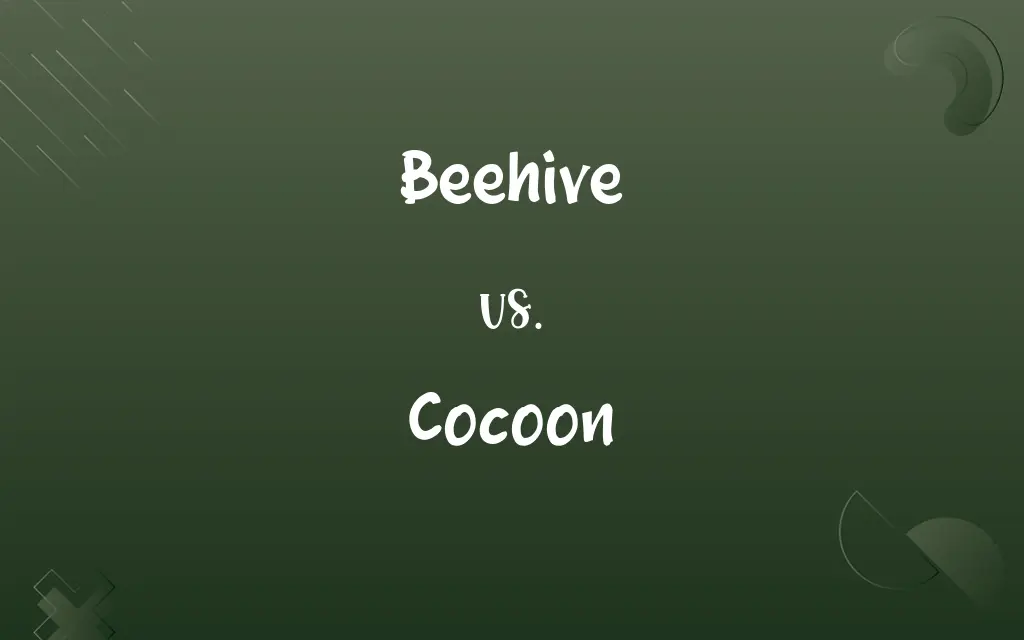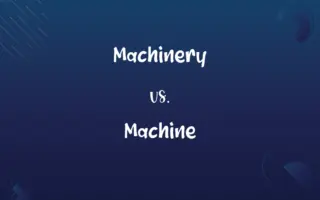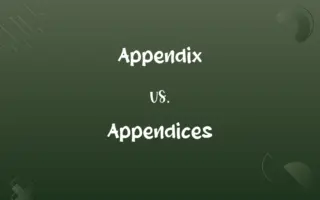Beehive vs. Cocoon: Know the Difference

By Dua Fatima & Shumaila Saeed || Updated on March 4, 2024
A beehive is a structure where bees live and produce honey, symbolizing community and industry, while a cocoon is a protective casing spun by insects for metamorphosis, symbolizing transformation and growth.

Key Differences
A beehive is an intricate structure built by bees to live, breed, and store honey and pollen. Conversely, a cocoon is created by a single insect, such as a moth or a butterfly larva, as a protective layer during its pupal stage before transforming into its young form.
Dua Fatima
Mar 04, 2024
Beehives serve as a central hub for the complex social structure of bee colonies, where thousands of bees work collectively for the survival and prosperity of their hive. In contrast, cocoons are isolated enclosures, safeguarding individual insects during their vulnerable phase of metamorphosis.
Dua Fatima
Mar 04, 2024
While beehives are primarily associated with honeybees and represent industry, teamwork, and productivity, cocoons symbolize individual growth, change, and the emergence of new beginnings. This contrast highlights the communal versus solitary aspects of nature.
Dua Fatima
Mar 04, 2024
The construction of a beehive involves collective effort and coordination among bees, showcasing remarkable examples of natural architecture and teamwork. On the other hand, the creation of a cocoon is a solitary task, showcasing an insect's instinctual drive for survival and transformation.
Shumaila Saeed
Mar 04, 2024
Environmental and human impacts on beehives include threats like habitat destruction, pesticides, and climate change, affecting bee populations and, by extension, global agriculture. Conversely, cocoons and their inhabitants face similar threats but are also emblematic of nature's resilience and the potential for renewal and adaptation.
Shumaila Saeed
Mar 04, 2024
ADVERTISEMENT
Comparison Chart
Symbolism
Community, industry, teamwork.
Transformation, growth, new beginnings.
Dua Fatima
Mar 04, 2024
Environmental Impact
Affected by pesticides, climate change.
Threatened by habitat destruction, climate change.
Shumaila Saeed
Mar 04, 2024
ADVERTISEMENT
Beehive and Cocoon Definitions
Beehive
Home for Bees: A beehive is where bees live and work.
The beehive was buzzing with activity.
Shumaila Saeed
Mar 04, 2024
Cocoon
Protective Case: A cocoon is a protective casing spun by insects.
The caterpillar spun a cocoon to begin its transformation.
Shumaila Saeed
Mar 04, 2024
Beehive
Honey Production: Beehives are essential for honey production.
They harvested honey from the beehive in their backyard.
Shumaila Saeed
Mar 04, 2024
Cocoon
Metamorphosis: Cocoons are critical for insect metamorphosis.
Inside the cocoon, the larva transforms into a butterfly.
Dua Fatima
Mar 04, 2024
Beehive
Symbol of Productivity: Beehives symbolize industry and cooperation.
The team worked like a beehive, efficient and united.
Dua Fatima
Mar 04, 2024
ADVERTISEMENT
Cocoon
Symbol of Change: Cocoons represent personal growth and transformation.
After months of isolation, she emerged from her cocoon of self-discovery.
Dua Fatima
Mar 04, 2024
Beehive
Natural Architecture: Beehives showcase intricate natural design.
The geometric patterns of the beehive impressed the scientists.
Dua Fatima
Mar 04, 2024
Cocoon
Nature's Ingenuity: Cocoons illustrate nature's survival mechanisms.
The cocoon's design protects the pupa from predators.
Dua Fatima
Mar 04, 2024
Beehive
Ecological Importance: Beehives play a crucial role in pollination.
The presence of a beehive can significantly increase crop yields.
Dua Fatima
Mar 04, 2024
Cocoon
Isolation for Growth: Cocoons signify solitary growth.
The artist likened his creative process to being in a cocoon.
Shumaila Saeed
Mar 04, 2024
Cocoon
Silky envelope spun by the larvae of many insects to protect pupas and by spiders to protect eggs
Dua Fatima
Oct 19, 2023
Cocoon
Something that envelops, protects, or isolates
"a star hidden in a cocoon of dust" (Freeman Dyson). "Actors live in a cocoon of praise. They never meet people who don't like them" (Robert Morley).
Dua Fatima
Oct 19, 2023
Cocoon
A protective case of silk or similar fibrous material spun by the larvae of moths and certain other insects as a cover for the pupa.
Dua Fatima
Oct 19, 2023
Cocoon
A similar natural protective covering or structure, such as the egg case of a spider.
Dua Fatima
Oct 19, 2023
Cocoon
A protective plastic coating that is placed over stored military or naval equipment.
Dua Fatima
Oct 19, 2023
Cocoon
To cause to be isolated or protected from harsh, dangerous, or disturbing realities; insulate.
Dua Fatima
Oct 19, 2023
Cocoon
The silky protective case spun by the larvae of some insects in which they metamorphose, the pupa.
Dua Fatima
Oct 19, 2023
Cocoon
An oblong case in which the silkworm lies in its chrysalis state. It is formed of threads of silk spun by the worm just before leaving the larval state. From these the silk of commerce is prepared.
Dua Fatima
Oct 19, 2023
Cocoon
To be isolated or protected from harsh, dangerous, or disturbing realities, especially by remaining indoors at home in one's free time.
Dua Fatima
Oct 19, 2023
Cocoon
Retreat as if into a cocoon, as from an unfriendly environment;
Families cocoon around the T.V. set most evenings
She loves to stay at home and cocoon
Dua Fatima
Oct 19, 2023
Repeatedly Asked Queries
What does a cocoon symbolize?
A cocoon symbolizes transformation, personal growth, and the emergence of new life.
Hifza Nasir
Mar 04, 2024
How are beehives constructed?
Beehives are constructed through the collective effort and coordination of bee colonies, creating intricate structures.
Hifza Nasir
Mar 04, 2024
How does a cocoon function?
A cocoon functions as a protective casing for insects during their pupal stage, facilitating safe metamorphosis.
Dua Fatima
Mar 04, 2024
Are cocoons only made by butterflies and moths?
While commonly associated with butterflies and moths, various insects spin cocoons for protection during their developmental stages.
Hifza Nasir
Mar 04, 2024
What threats do beehives face?
Beehives face threats from habitat destruction, pesticides, and climate change, impacting bee populations and agriculture.
Shumaila Saeed
Mar 04, 2024
What is the purpose of a beehive?
A beehive serves as a home for bees where they breed, store honey and pollen, and support a complex social structure.
Dua Fatima
Mar 04, 2024
Can humans replicate beehive structures?
Yes, humans have created artificial beehives to house bee colonies for honey production and study.
Shumaila Saeed
Mar 04, 2024
Who creates a cocoon?
A cocoon is created by an individual insect, such as a moth or butterfly larva, as part of their developmental process.
Dua Fatima
Mar 04, 2024
What role do bees in a beehive play in agriculture?
Bees play a crucial role in pollination, essential for the reproduction of many plants and crops.
Dua Fatima
Mar 04, 2024
How do beehives contribute to biodiversity?
Beehives contribute to biodiversity by supporting bee populations that pollinate a wide range of plants.
Shumaila Saeed
Mar 04, 2024
What does a beehive symbolize?
A beehive symbolizes community, teamwork, and productivity.
Dua Fatima
Mar 04, 2024
How do environmental changes affect cocoons?
Environmental changes can threaten cocoons by altering the habitats necessary for the safe development of the insects within.
Dua Fatima
Mar 04, 2024
Is the process of emerging from a cocoon quick?
The process varies among species but generally involves significant time for the insect to develop and emerge fully transformed.
Dua Fatima
Mar 04, 2024
Can all insects create cocoons?
Not all insects create cocoons; this behavior is specific to certain species undergoing complete metamorphosis.
Dua Fatima
Mar 04, 2024
What can be done to protect beehives and cocoons?
Protecting habitats, reducing pesticide use, and supporting conservation efforts can help safeguard beehives and cocoons.
Dua Fatima
Mar 04, 2024
Share this page
Link for your blog / website
HTML
Link to share via messenger
About Author
Written by
Dua FatimaCo-written by
Shumaila SaeedShumaila Saeed, an expert content creator with 6 years of experience, specializes in distilling complex topics into easily digestible comparisons, shining a light on the nuances that both inform and educate readers with clarity and accuracy.









































































